Characteristics of Bow-Tie Antenna Structures for Semi-Insulating GaAs and InP Photoconductive Terahertz Emitters
Abstract
1. Introduction
2. Methods
2.1. Theoretical Characterization of Photoconductive Terahertz Emitters
2.2. Experimental Characterization of Photoconductive Terahertz Emitters
3. Results and Discussion
4. Conclusions
Author Contributions
Funding
Conflicts of Interest
References
- Son, J.-H. Terahertz electromagnetic interactions with biological matter and their applications. J. Appl. Phys. 2009, 105, 102033. [Google Scholar] [CrossRef]
- Alfihed, S.; Holzman, J.F.; Foulds, I.G. Developments in the integration and application of terahertz spectroscopy with microfluidics. Biosens. Bioelectron. 2020, 165, 112393. [Google Scholar] [CrossRef] [PubMed]
- Lewis, R.A. A review of terahertz sources. J. Phys. D. Appl. Phys. 2014, 47, 374001. [Google Scholar] [CrossRef]
- Rice, A.; Jin, Y.; Ma, X.F.; Zhang, X.-C. Terahertz optical rectification from <110> zinc-blende crystals. Appl. Phys. Lett. 1998, 64, 1324–1326. [Google Scholar] [CrossRef]
- Auston, D.H.; Cheung, K.P.; Smith, P.R. Picosecond photoconducting Hertzian dipoles. Appl. Phys. Lett. 1984, 45, 284–286. [Google Scholar] [CrossRef]
- Miyamaru, F.; Saito, Y.; Yamamoto, K.; Furuya, T.; Nishizaw, S.; Tani, M. Dependence of emission of terahertz radiation on geometrical parameters of dipole photoconductive antennas. Appl. Phys. Lett. 2010, 96, 211104. [Google Scholar] [CrossRef]
- Maraghechi, P.; Elezzabi, A.Y. Fractal Structures for THz Radiation Emitters. IEEE J. Sel. Top. Quantum Electron. 2013, 19, 8400310. [Google Scholar] [CrossRef]
- Burford, N.M.; El-Shenawee, M.O. Review of terahertz photoconductive antenna technology. Opt. Eng. 2017, 56, 010901. [Google Scholar] [CrossRef]
- Gu, P.; Tani, M.; Kono, S.; Sakai, K. Study of terahertz radiation from InAs and InSb. J. Appl. Phys. 2002, 91, 5533–5537. [Google Scholar] [CrossRef]
- Suzukia, M.; Tonouchi, M. Fe-implanted InGaAs terahertz emitters for 1.56μm wavelength excitation. Appl. Phys. Lett. 2005, 86, 051104. [Google Scholar] [CrossRef]
- Ascázubi, R.; Shneider, C.; Wilke, I.; Pino, R.; Dutta, P.S. Enhanced terahertz emission from impurity compensated GaSb. Phys. Rev. B. 2005, 72, 045328. [Google Scholar] [CrossRef]
- Tan, K.H.; Yoon, S.F.; Wicaksono, S.; Loke, W.K.; Li, D.S.; Saadsaoud, N.; Tripon-Canseliet, C.; Lampin, J.F.; Decoster, D.; Chazelas, J. Low temperature grown GaNAsSb: A promising material for photoconductive switch application. Appl. Phys. Lett. 2013, 103, 111113. [Google Scholar] [CrossRef]
- Shi, W.; Hou, L.; Liu, Z.; Tongue, T. Terahertz generation from SI-GaAs stripline antenna with different structural parameters. J. Opt. Soc. Am. B 2009, 26, A107–A112. [Google Scholar] [CrossRef]
- Collier, C.M.; Stirling, T.J.; Hristovski, I.R.; Krupa, J.D.A.; Holzman, J.F. Photoconductive terahertz generation from textured semiconductor materials. Sci. Rep. 2016, 6, 23185. [Google Scholar] [CrossRef] [PubMed]
- Cai, Y.; Brener, I.; Lopata, J.; Wynn, J.; Pfeiffer, L.; Federici, J. Design and performance of singular electric field terahertz photoconducting antennas. Appl. Phys. Lett. 1997, 71, 2076–2078. [Google Scholar] [CrossRef]
- Tani, M.; Matsuura, S.; Sakai, K.; Nakashima, S. Emission characteristics of photoconductive antennas based on low-temperature-grown GaAs and semi-insulating GaAs. Appl. Opt. 1997, 36, 7853–7859. [Google Scholar] [CrossRef] [PubMed]
- Gallot, G.; Zhang, J.; McGowan, R.W.; Jeon, T.-I.; Grischkowsky, D. Measurements of the THz absorption and dispersion of ZnTe and their relevance to the electro-optic detection of THz radiation. Appl. Phys. Lett. 1999, 74, 3450. [Google Scholar] [CrossRef]
- Yang, Y.; Singh, R.; Zhang, W. Anomalous terahertz transmission in bow-tie plasmonic antenna apertures. Opt. Lett. 2011, 36, 2901–2903. [Google Scholar] [CrossRef] [PubMed]
- Collier, C.M.; Stirling, T.J.; Dekock-Kruger, S.; Holzman, J.F. Spectral Response Tuning of Photoconductive Terahertz Emitters With Binary Phase Masks. IEEE J. Sel. Top. Quantum Electron. 2017, 23, 8500406. [Google Scholar] [CrossRef]
- Alfihed, S.; Jenne, M.F.; Ciocoiu, A.; Foulds, I.G.; Holzman, J.F. Photoconductive terahertz generation in semi-insulating GaAs and InP under the extremes of bias field and pump fluence. Opt. Lett. 2020, 46, 572–575. [Google Scholar] [CrossRef] [PubMed]
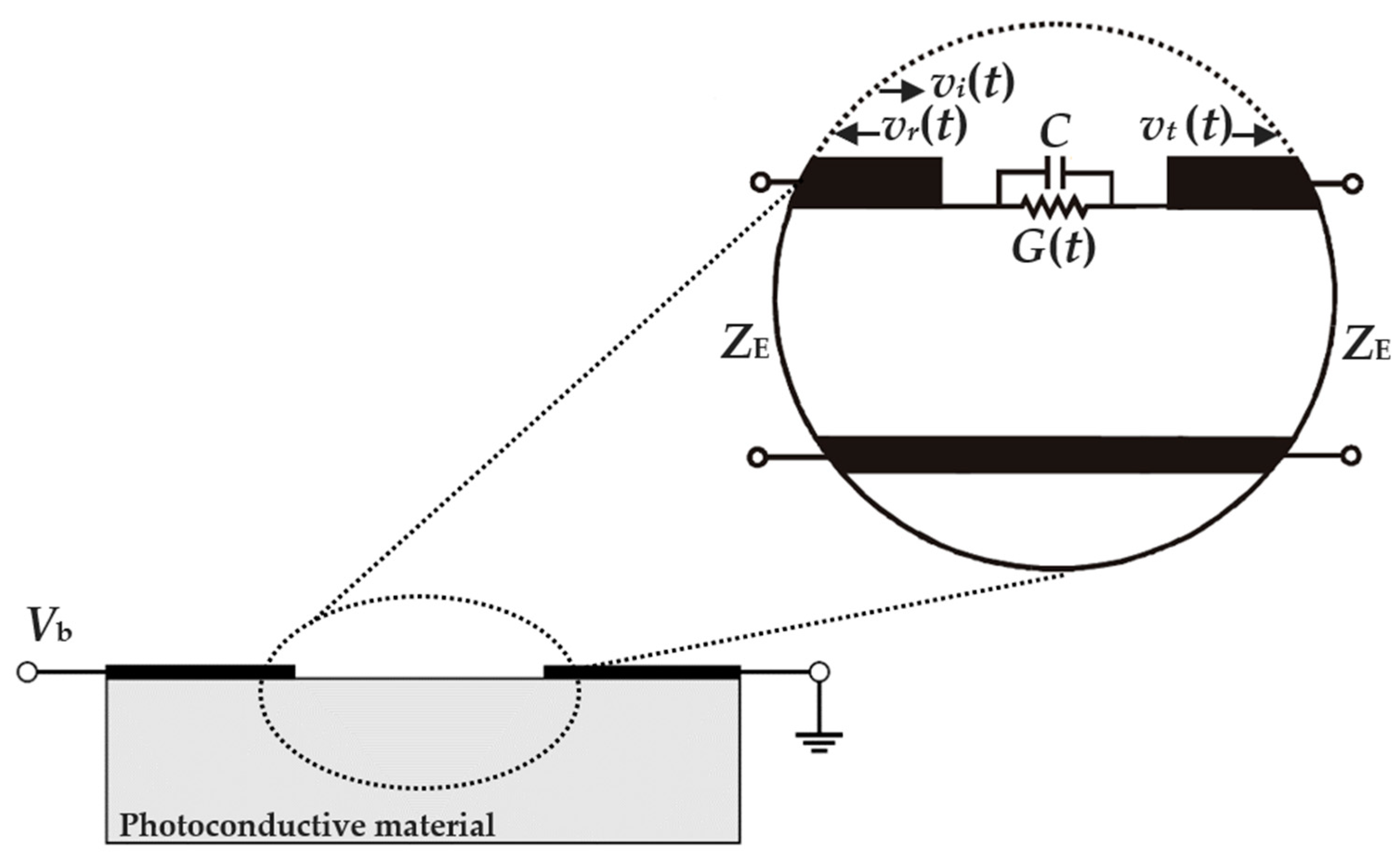
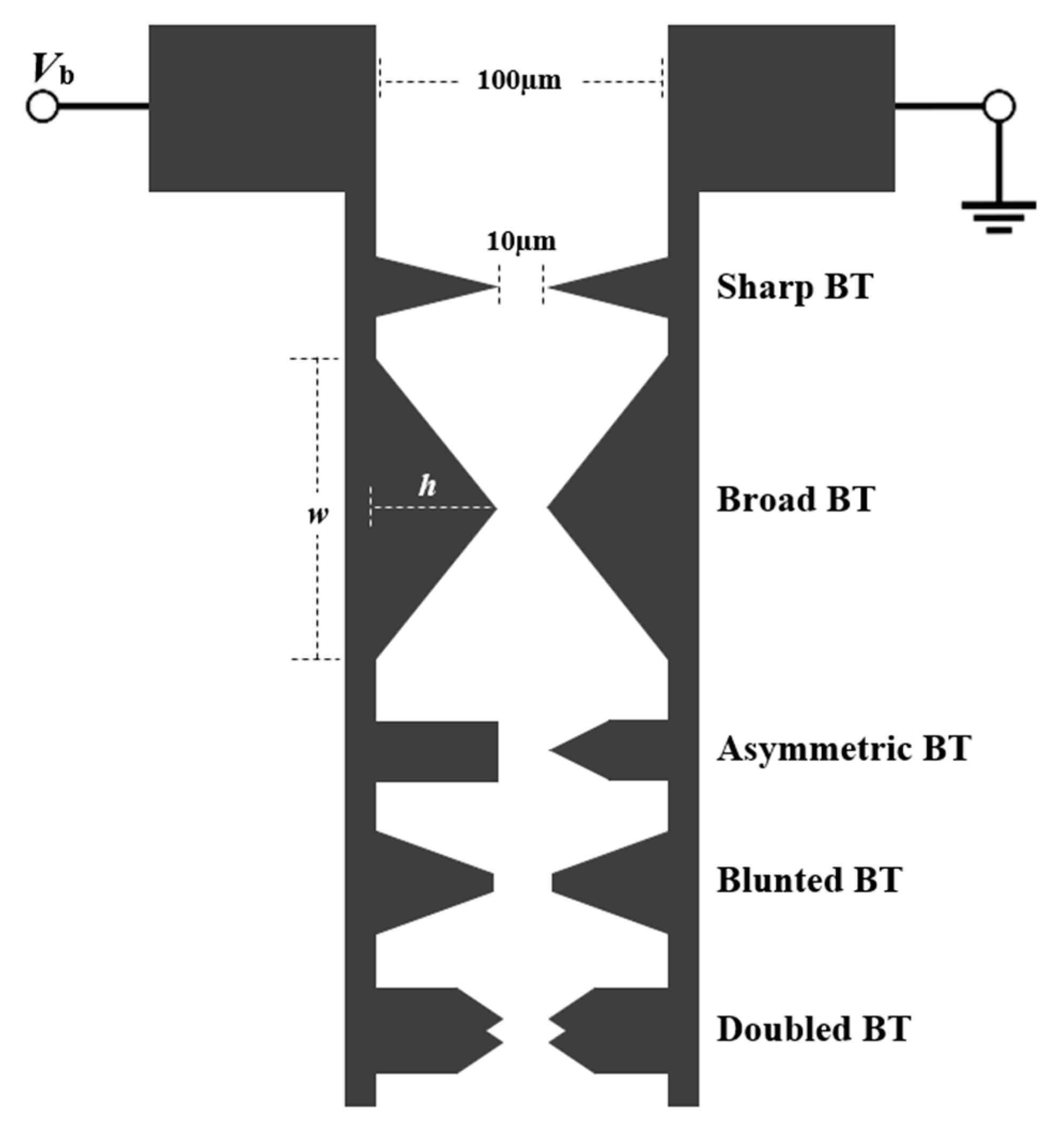



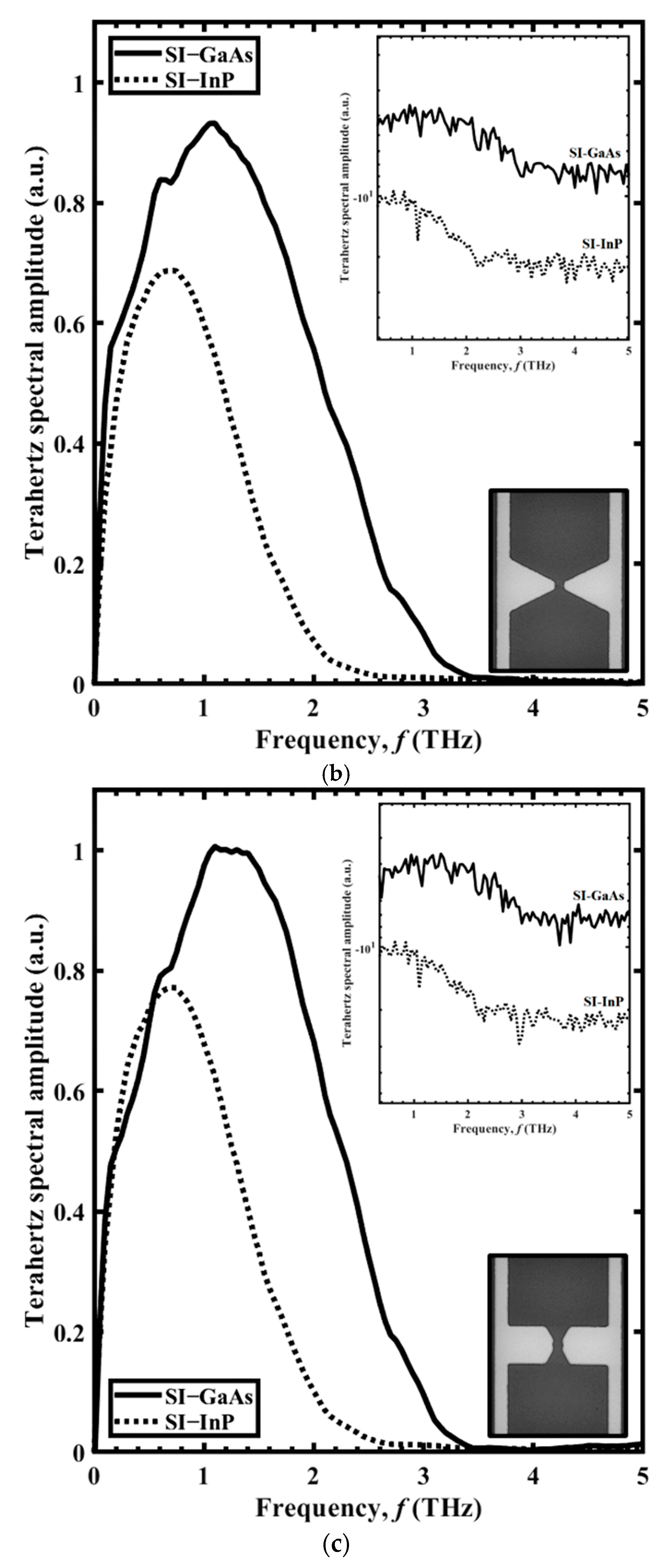
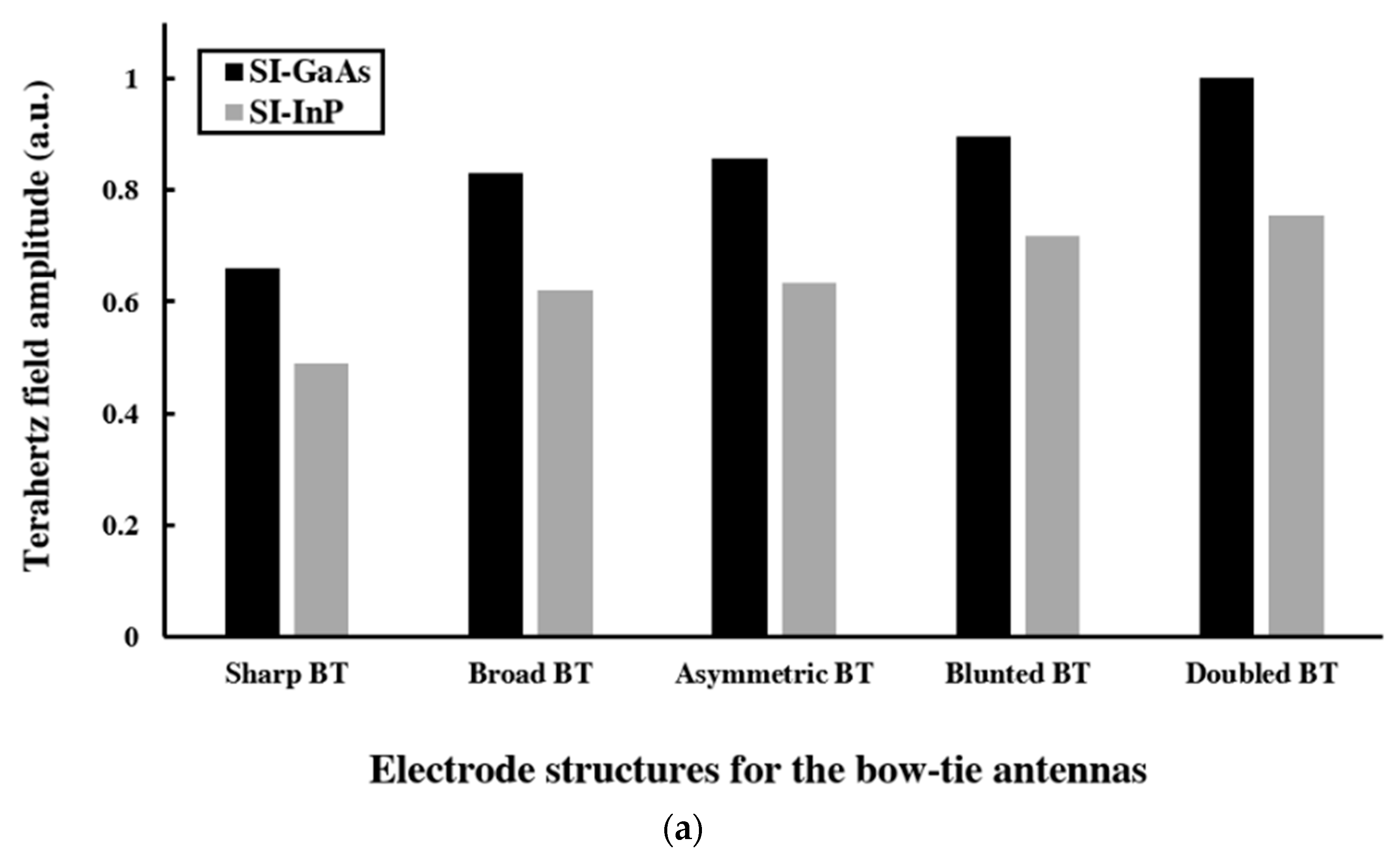
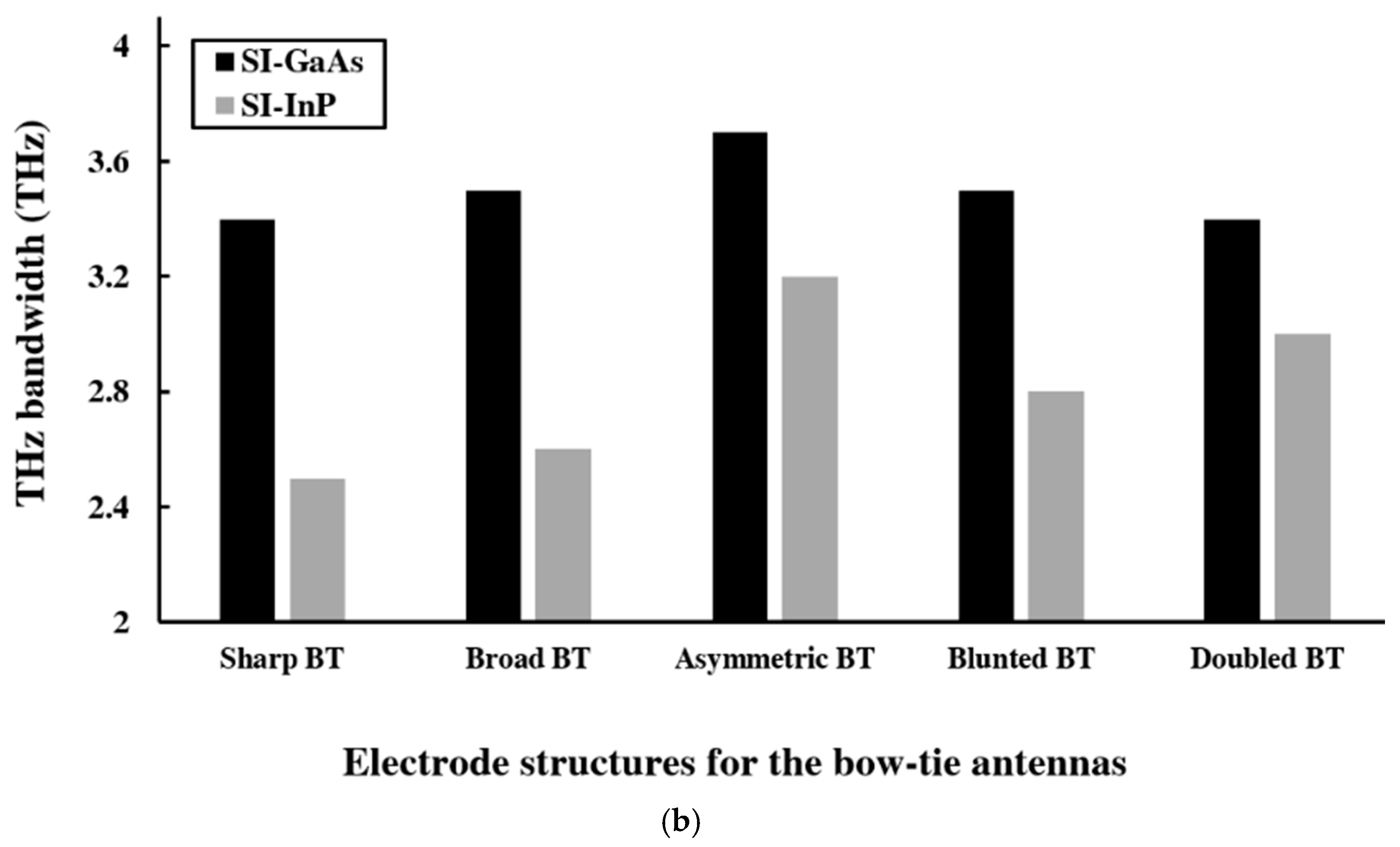
Publisher’s Note: MDPI stays neutral with regard to jurisdictional claims in published maps and institutional affiliations. |
© 2021 by the authors. Licensee MDPI, Basel, Switzerland. This article is an open access article distributed under the terms and conditions of the Creative Commons Attribution (CC BY) license (https://creativecommons.org/licenses/by/4.0/).
Share and Cite
Alfihed, S.; Foulds, I.G.; Holzman, J.F. Characteristics of Bow-Tie Antenna Structures for Semi-Insulating GaAs and InP Photoconductive Terahertz Emitters. Sensors 2021, 21, 3131. https://doi.org/10.3390/s21093131
Alfihed S, Foulds IG, Holzman JF. Characteristics of Bow-Tie Antenna Structures for Semi-Insulating GaAs and InP Photoconductive Terahertz Emitters. Sensors. 2021; 21(9):3131. https://doi.org/10.3390/s21093131
Chicago/Turabian StyleAlfihed, Salman, Ian G. Foulds, and Jonathan F. Holzman. 2021. "Characteristics of Bow-Tie Antenna Structures for Semi-Insulating GaAs and InP Photoconductive Terahertz Emitters" Sensors 21, no. 9: 3131. https://doi.org/10.3390/s21093131
APA StyleAlfihed, S., Foulds, I. G., & Holzman, J. F. (2021). Characteristics of Bow-Tie Antenna Structures for Semi-Insulating GaAs and InP Photoconductive Terahertz Emitters. Sensors, 21(9), 3131. https://doi.org/10.3390/s21093131





